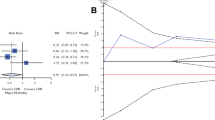Abstract
Introduction
During laparoscopic cholecystectomy (LC), common bile duct (CBD) visualization either directly or with cholangiography (IOC) is less routine. Cholangiography can be used to identify and possibly prevent bile duct injury (BDI), which is a dreaded complication of cholecystectomy. The purpose of our study was to evaluate the trend of IOC/CBD exploration and BDI during LC for benign disease.
Methods
A state-wide database (SPARCS) was used to identify all LC for benign biliary non-obstructive and obstructive disease between 2000 and 2014 in the state of New York. ICD-9 and CPT codes were used to identify IOC/CBD exploration and BDI. Multivariable logistic regression models were used in examining the linear trend in the risk of complication, 30-day readmission, 30-day ED visits, and BDI among all cholangiogram patients after controlling for possible confounding factors.
Results
During 2000–2014, 391,945 patients underwent laparoscopic cholecystectomy. The trend of IOC/CBD exploration performed significantly decreased for LC overall (12.37–10.44%, relative risk = 0.98, p <.0001) and particularly, in the outpatient setting (10.77–7.52%, relative risk = 0.96, p value <.0001). Among patients with IOC, overall complication rate, 30-day readmission rate, and 30-day ED visit rates increased. When looking at overall complication rate, there was an increase by about 4% per year (relative risk = 1.04, p value <.0001). After controlling for confounding factors, the complication risk and 30-day ED visit risk increased through years, while the 30-day readmission risk did not have significant change. Risk of BDI also increased significantly (p = 0.03).
Conclusion
In an era of laparoscopy, the rate of IOC/CBD exploration during LC has significantly decreased, while BDI significantly increased.

Similar content being viewed by others
References
Truven Health Analytics (Thomson/Solucient), USA Procedure Volumes 2014
Calland JF, Tanaka K, Foley E et al (2001) Outpatient laparoscopic cholecystectomy: patient outcomes after implementation of a clinical pathway. Ann Surg 233(5):704–715
Shea JA, Berlin JA, Bachwich DR et al (1998) Indications for and outcomes of cholecystectomy: a comparison of the pre and postlaparoscopic eras. Ann Surg 227(3):343–350
Lillemoe KD, Lin JW, Talamini MA, Yeo CJ, Snyder DS, Parker SD (1999) Laparoscopic cholecystectomy as a “true” outpatient procedure: initial experience in 130 consecutive patients. J Gastrointest Surg 3(1):44–49
Giger UF, Michel JM, Opitz I et al (2006) Risk factors for perioperative complications in patients undergoing laparoscopic cholecystectomy: analysis of 22,953 consecutive cases from the Swiss Association of Laparoscopic and Thoracoscopic Surgery database. J Am Coll Surg 203(5):723–728
Halbert C, Pagkratis S, Yang J et al (2016) Beyond the learning curve: incidence of bile duct injuries following laparoscopic cholecystectomy normalize to open in the modern era. Surg Endosc 30(6):2239–2243
Archer SB, Brown DW, Smith CD, Branum GD, Hunter JG (2001) Bile duct injury during laparoscopic cholecystectomy: results of a national survey. Ann Surg 234(4):549–558
Halbert C, Altieri MS, Yang J et al (2016) Long-term outcomes of patients with common bile duct injury following laparoscopic cholecystectomy. Surg Endosc 30(10):4294–4299
Kern KA (1997) Malpractice litigation involving laparoscopic cholecystectomy. Cost, cause, and consequences. Arch Surg 132(4):392–397
Vezakis A, Davides D, Ammori BJ, Martin IG, Larvin M, McMahon MJ (2000) Intraoperative cholangiography during laparoscopic cholecystectomy. Surg Endosc 14(12):1118–1122
Kullman Borch K, Lindstrom E, Svanvik J, Anderberg B (1996) Value of routine intraoperative cholangiography in detecting aberrant bile ducts and bile duct injuries during laparoscopic cholecystectomy. Br J Surg 83(2):171–175
Buddingh KT, Weersma RK, Savenije RA, van Dam GM, Nieuwenhuijs VB (2011) Lower rate of major bile duct injury and increased intraoperative management of common bile duct stones after implementation of routine intraoperative cholangiography. J Am Coll Surg 213(2):267–274
Massarweh NN, Flum DR (2007) Role of intraoperative cholangiography in avoiding bile duct injury. J Am Coll Surg 204(4):656–664
Peduzzi P, Concato J, Kemper E, Holford TR, Feinstein AR (1996) A simulation study of the number of events per variable in logistic regression analysis. J Clin Epidemiol 49(12):1373–1379
Mirizzi PL (1937) Operative cholangiography. Surg Gynecol Oncol 65:702–710
Soper NJ, Brunt LM (1994) The case for routine operative cholangiography during laparoscopic cholecystectomy. Surg Clin North Am 74(4):953–959
Flum DR, Dellinger EP, Cheadle A, Chan L, Koepsell T (2003) Intraoperative cholangiography and risk of common bile duct injury during cholecystectomy. JAMA 289(13):1639–1644
Ladocsi LT, Benitez LD, Filippone DR, Nance FC (1997) Intraoperative cholangiography in laparoscopic cholecystectomy: a review of 734 consecutive cases. Am Surg 63(2):150–156
Woods MS, Traverso LW, Kozarek RA et al (1995) Biliary tract complications of laparoscopic cholecystectomy are detected more frequently with routine intraoperative cholangiography. Surg Endosc 9(10):1076–1080
Fletcher DR, Hobbs MS, Tan P et al (1999) Complications of cholecystectomy: risks of the laparoscopic approach and protective effects of operative cholangiography: a population-based study. Ann Surg 229(4):449–457
Pucher PH, Brunt LM, Fanelli RD, Asbun HJ, Aggarwal R (2015) SAGES expert Delphi consensus: critical factors for safe surgical practice in laparoscopic cholecystectomy. Surg Endosc 29(11):3074–3085
Alvarez FA, de Santibanes M, Palavecino M et al (2014) Impact of routine intraoperative cholangiography during laparoscopic cholecystectomy on bile duct injury. Br J Surg 101(6):677–684
Giger U, Ouaissi M, Schmitz SF, Krähenbühl S, Krähenbühl L (2011) Bile duct injury and use of cholangiography during laparoscopic cholecystectomy. Br J Surg 98(3):391–396
Acknowledgement
We acknowledge the biostatistical consultation and support from the Biostatistical Consulting Core at the School of Medicine, Stony Brook University.
Author information
Authors and Affiliations
Corresponding author
Ethics declarations
Disclosures
No industry or other external funding was used for this research. Dr. Pryor receives honoraria for speaking for Ethicon, Medtronic, Stryker, and Gore; is a consultant for Medicines Company, Merck, and Intuitive, and has ownership interest in Transenterix.
Rights and permissions
About this article
Cite this article
Altieri, M.S., Yang, J., Obeid, N. et al. Increasing bile duct injury and decreasing utilization of intraoperative cholangiogram and common bile duct exploration over 14 years: an analysis of outcomes in New York State. Surg Endosc 32, 667–674 (2018). https://doi.org/10.1007/s00464-017-5719-2
Received:
Accepted:
Published:
Issue Date:
DOI: https://doi.org/10.1007/s00464-017-5719-2




